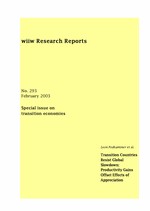Transition Countries Resist Global Slowdown: Productivity Gains Offset Effects of Appreciation
wiiw Research Report No. 293, February 2003
106 pages including 37 Tables, 10 Figures and 4 Panels
You can also download separate country reports of this report
| No. | Title | Author | |
|---|---|---|---|
| 1 | Country Report Bulgaria: economic consolidation making headway | Anton Mihailov | Free Download |
| 2 | Country Report Croatia: private consumptions boosted by bank loans | Hermine Vidovic | Free Download |
| 3 | Country Report Czech Republic: the czech economy dragging its feet | Josef Pöschl | Free Download |
| 4 | Country Report Hungary: the election year is over, repair of damages may begin | Sandor Richter | Free Download |
| 5 | Country Report Poland: muddling through | Leon Podkaminer | Free Download |
| 6 | Country Report Romania: robust growth | Gabor Hunya | Free Download |
| 7 | Country Report Russian Federation: GDP growth weakens, investments disappoint | Peter Havlik | Free Download |
| 8 | Country Report Serbia and Montenegro: Yugoslavia becomes Serbia and Montenegro | Vladimir Gligorov | Free Download |
| 9 | Country Report Slovakia: growth backed by domestic demand | Zdenek Lukas | Free Download |
| 10 | Country Report Slovenia: sizeable current account surplus | Hermine Vidovic | Free Download |
| 11 | Country Report Ukraine: boom over, debts due | Helen Boss Heslop | Free Download |
After satisfactory performance of the transition countries in 2000, their growth slowed down in 2001 as the external conditions deteriorated. This tendency was checked in the second half of 2002. Industrial production and exports have generally strengthened since then - though in some countries apparently only temporarily. Expanding consumption was the major factor supporting growth in the year 2002 as the capital formation was generally weak in the more advanced countries and only moderately strong in the less advanced ones.
The contribution of foreign trade to GDP growth in 2002 seems on the whole positive, excepting Russia and most post-Yugoslav countries. Despite weak growth in the EU, exports of the accession countries (and of Ukraine) performed quite well. This must be attributed to the ongoing growth in labour productivity and related cost improvements in industry which kept exports competitive. Gains in labour productivity are generally associated with some cuts in employment, adding to unemployment which is generally high, or very high, and unlikely to go down significantly even in the medium run.
There has been a continuous decline in inflation. In most cases the disinflation is gradual and appears to be little affected by the monetary and fiscal policies. Inertial cost-price adjustments are likely to continue in the foreseeable future. The remarkable strength of the national currencies appears to have had a fairly limited impact on the performance of trade and production so far. The recent years' exchange rate trends may have reflected financial (or even speculative) developments so that a potential for adjustments, involving devaluation, may be there. But the likelihood of major adjustments seems rather small because the solid capital inflows will continue even in the medium term, especially in view of the prospective EU membership of the candidate countries. The general concern over potential loss of competitiveness due to overvaluation remains still valid. However, the productivity and efficiency gains may offset the negative consequences of real appreciation and the process has been associated with quality and price gains in export activities. It is not clear yet how sustainable the process of productivity improvements will be. Most probably high levels of investment (including green-field FDI) are needed to maintain its momentum.
Growth acceleration in 2003-04 is possible provided the business climate in the EU improves. Otherwise growth rates will be roughly the same as in 2002. In any case the average rate of catching-up vis-à-vis the EU will stay at about 2 percentage points per year.
Keywords: Central and East European transition countries, Bulgaria, Croatia, Czech Republic, Hungary, Macedonia, Poland, Romania, Russia, Slovakia, Slovenia, Ukraine, Yugoslavia (Serbia and Montenegro), forecast, East-West trade, European Union, EU enlargement, exchange rates
JEL classification: O52, O57, P24, P27, P33, P52
Countries covered: Bulgaria, Croatia, Czechia, Hungary, North Macedonia, Poland, Romania, Russia, Serbia and Montenegro, Slovakia, Slovenia, Ukraine, Wider Europe, SEE, Visegrad countries
Research Areas: Macroeconomic Analysis and Policy
